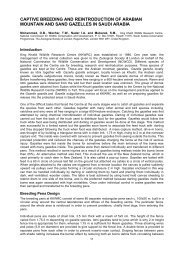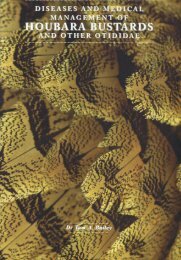His Highness Sheikh Zayed bin Sultan Al Nahyan - Wildlife Middle ...
His Highness Sheikh Zayed bin Sultan Al Nahyan - Wildlife Middle ...
His Highness Sheikh Zayed bin Sultan Al Nahyan - Wildlife Middle ...
Create successful ePaper yourself
Turn your PDF publications into a flip-book with our unique Google optimized e-Paper software.
15<br />
A Practical Technique for Fieldworkers<br />
Interested in Serological Testing Populations of<br />
Wild Raptors<br />
Tom Bailey 1 and Ullie Wernery 2<br />
1Dubai Falcon Hospital, PO Box 23919, Dubai, United<br />
Arab Emirates<br />
2Central Veterinary Research Laboratory, P. O. Box<br />
597, Dubai, United Arab Emirates<br />
Veterinary issues in free-living raptor populations<br />
are becoming increasingly important to biologists and<br />
conservationists. The use of the anti-inflammatory drug,<br />
diclofenac in livestock has caused a devastating decline of<br />
vulture populations in India (Meteyer et al, 2004);<br />
indiscriminate application of the rodenticide bromdialone in<br />
Mongolia has caused massive declines in saker falcons (see<br />
Falco 23), while West Nile virus has been associated with an<br />
increase in raptor mortality in the USA (Joyner et al, 2004).<br />
It is possible to collect and even analyse many<br />
veterinary samples during fieldwork if you are properly<br />
equipped with a generator and portable, robust equipment<br />
(e.g. freezers, centrifuges, and microscopes). However, such<br />
equipment is, unfortunately, not available to the majority of<br />
field biologists.<br />
We report an easy, practical technique that could<br />
be used by our biologist colleagues who handle wild birds<br />
of prey and who are interested in collecting samples, but<br />
who do not have the luxury of being able to take a vet and<br />
his or her field equipment along with them.<br />
This method has been used on samples collected<br />
from wild houbara bustards during hunting trips in Pakistan<br />
that have been subsequently analysed in a laboratory to<br />
check for antibodies against a selection of viral diseases<br />
(Wernery et al, 2001). The technique is simple and involves<br />
placing 2-3 drops of whole blood onto a filter paper strip<br />
(Scheicher and Schuell, Germany, H 740-E, 203x254mm).<br />
The filter paper is dried for several hours to avoid bacterial<br />
and fungal growth and then kept in a closed box until the<br />
field work is finished. In the study by Wernery et al (2001)<br />
the filter papers were tested at the Central Veterinary<br />
Research Laboratory in Dubai for antibodies against<br />
Newcastle disease and avian influenza using standard<br />
methods. It is probably possible to test for other avian<br />
diseases using this method (Wernery et al, 2003).<br />
Serological surveys are an important tool for<br />
assessing the range of diseases and their prevalence that a<br />
wildlife population is exposed to and surveys have been<br />
conducted in European raptor populations (Schettler et al,<br />
2001). To our knowledge, no surveys have been performed<br />
on raptor populations in Central Asia, although it is likely<br />
that wild raptors increasingly come into contact with feral<br />
or domestic birds and hence may be exposed to many<br />
important viral diseases of domestic birds. For example,<br />
over the last year avian influenza has been reported on many<br />
veterinary internet discussion groups as causing mortality in<br />
both captive and wild raptors in Asia.<br />
This simple technique could be readily used by<br />
raptor biologists, because other than the filter paper and box<br />
for samples, no expensive or bulky equipment is needed.<br />
Please contact us at the address above for further<br />
information.<br />
References<br />
Joyner, P.H., Kelly, S, Shreve, A.A., Snead, S.E., Sleeman,<br />
J.M. and Pettit, D.A. 2004. Outbreak of West Nile<br />
Virus in raptors from Virginia during 2003: clinical,<br />
diagnostic and epidemiologic findings. Proceedings<br />
of the American Association of Zoo Veterinarians,<br />
American Association of <strong>Wildlife</strong> Veterinarians and<br />
<strong>Wildlife</strong> Disease Association, San Diego, USA. Pp<br />
217-219.<br />
Meteyer, C.U., Rideout, B., Shivaprasad, H.L., Gilbert, M.,<br />
Oaks, L. 2004. Pathology of diclofenac poisonining<br />
in free-flying and expriemtally exposed oriental<br />
white-backed vultures (Gyps bengalensis).<br />
Proceedings of the American Association of Zoo<br />
Veterinarians, American Association of <strong>Wildlife</strong><br />
Veterinarians and <strong>Wildlife</strong> Disease Association,<br />
San Diego, USA. Pp 435-437.<br />
Schettler, E., Langgemach, T., Sommer, P., Streich, J. and<br />
Frolich, K. 2001. Seroepizootiology of selected<br />
infectious disease agents in free living birds of prey<br />
in Germany. Journal of <strong>Wildlife</strong> Diseases. 37: 145<br />
152.<br />
Wernery, U., Molnar, L., and Hunt, K. 2001. Disease status<br />
of wild houbara bustards (Chlamydotis undulata<br />
macqueenii). Proceedings of the European<br />
Association of Avian Veterinarians. Munich, March<br />
6-10, 2001. Pp 268-270.<br />
Wernery, U., Sanchez, A.L., Joseph, S and Wernery, R. 2003.<br />
Falconid response to the attenuated falcon<br />
herpesvirus vaccine DuFaHe. Proceedings of the<br />
European Association of Avian Veterinarians.<br />
Tenerife, April 22-26, 2003. Pp 191-193.<br />
Photo by S. Gombobaatar




